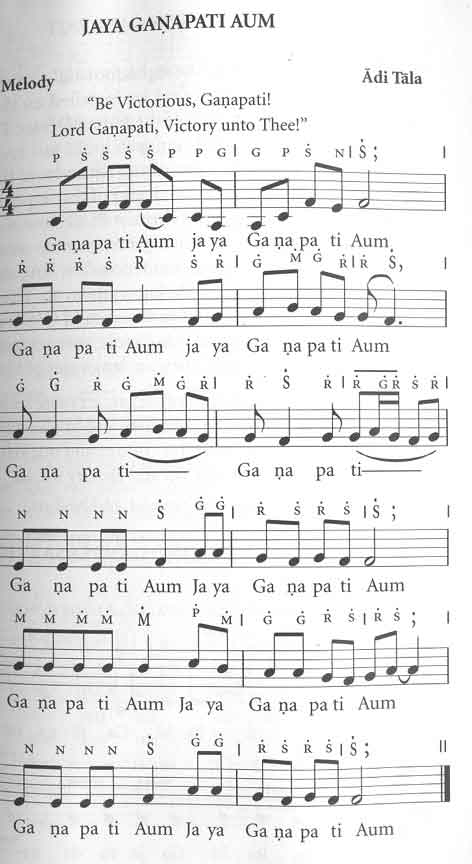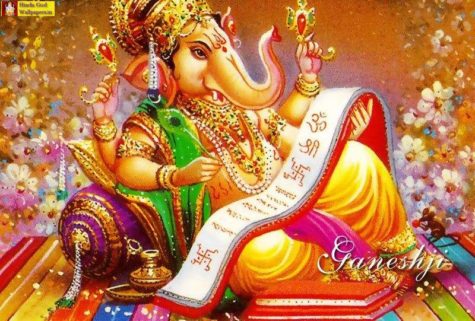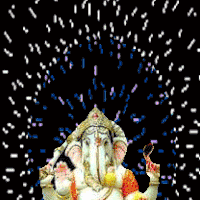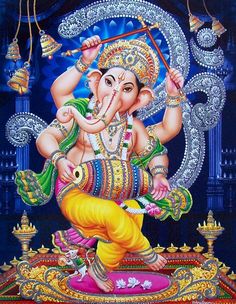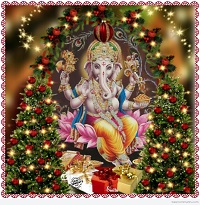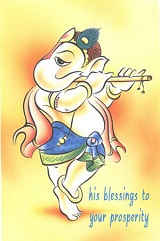Chanting
Singing To Ganesha
Shri Ganesha Upanishad
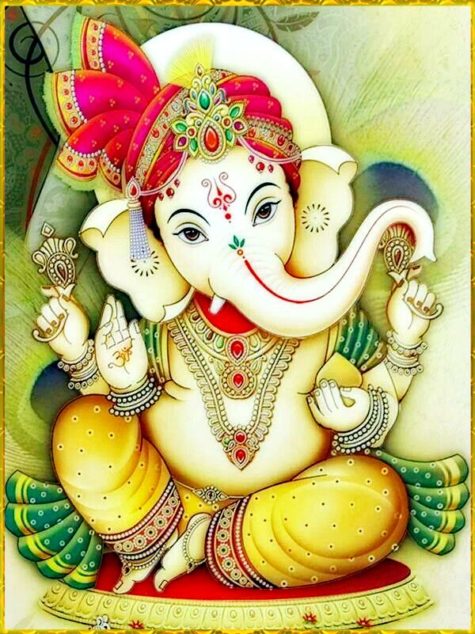
Aum! Let us listen with our ears to that which is auspicious, adorable one. Let us perceive with our eyes what is holy and auspicious. With strong, stable body and limbs, may we seek the divine grace and accept the noble order of all our life.
I surrender to you, Lord Ganesha. You are the speaker. You are the listener. You are the giver. You are the sustainer. I am your disciple. Protect me from the front and back. Protect me from the north and the south, from above and below. Protect me from all directions.
You are full of perfect knowledge of truth and awareness. You are full of bliss and pure consciousness. You are truth, consciousness and bliss. You are the absolute awareness. You are full of supreme wisdom and knowledge.
You are the earth, water, fire, air and the space. You are the root foundation of speech. You are beyond the three gunas: sattva, rajas, and tamas. You are beyond the physical, mental, and causal bodies. You are beyond the three aspects of time: past, present, and future. You are eternally established in the muladhara chakra. You have three shaktis: action, knowledge, and will.
Salutation to the Ganapati whose seed mantra is Aum Gam. We know Ekadanta, the One-tusked God, the unique God. We meditate upon Vakratunda, the curved-trunk God. May that unique elephant God illumine our consciousness and direct us along the right track.
One should meditate upon Lord Ganesha having one tusk and four arms; holding the noose and goad with two of them; with the other two indicating varada, the giving of boons and blessings, and abhaya mudra, the fear removing gesture; having a mouse as the emblem on his ensign; possessing a big, beautiful belly and large, lovely ears which look like winnowing baskets; having a red cloth and His whole body covered with red sandalwood paste. He should be worshiped with red flowers. He manifests Himself as the universe and is beyond pakriti, matter, and Parusha, the manifest God. One who worships Ganesha in this way forever is the best of yogis.
Prostrations to Vratapati, the Lord of Plenty. Prostrations to Ganapati, the Lord of various groups of Gods. Prostrations to Pramathapati, the Lord of Shiva’s hosts. Prostrations to Lambodara, the full-bellied God with a single tusk, destroyer of obstacles, the Son of Shiva, the Bestower of all Blessings.
He who chants this Ganapati Upanishad will verily get established in Brahman, the pure awareness. He will never encounter any obstacles. He will be happy everywhere. He will be free from the five great sins and lesser ones. By reciting this in the evening, the day’s sins are destroyed.
By reciting this in the early morning, one becomes free from the sins committed at night in dreams. Reciting this morning and evening, one becomes totally free from all sins. He becomes totally free from all obstacles. He achieves the four divine ends of life: dharma, artha, kama, and moksha; virtue, wealth, pleasure, and liberation.
Aum Ganesha saranam saranam Ganesha.
Excerpted from Ganapatyatharsirsham
Translation by Dr. Vasant Lad
Shlokas on Lord Ganesha
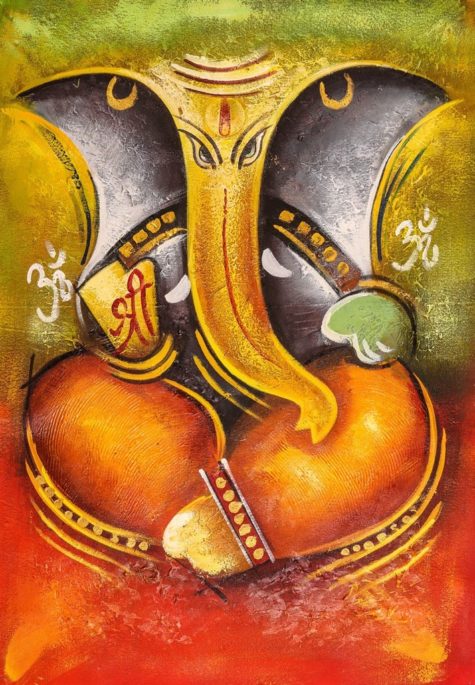
What is a Shloka?
Shloka is a Sanskrit word referring to a verse, proverb, hymn or poem that uses a specific meter. It is considered as the classic basis for epic Indian poetry as its use is widespread in traditional Sanskrit poems. Among the famous texts written entirely in shlokas are the “Ramayana” and “Mahabharata.”
Technically, a shloka can be made up of any sort of four-line stanza with up to 26 letters in a single line. In terms of yoga practice, it is likely that a yogi who meditates will come across this classical form of verse in the mantras that can help one meditate effectively.
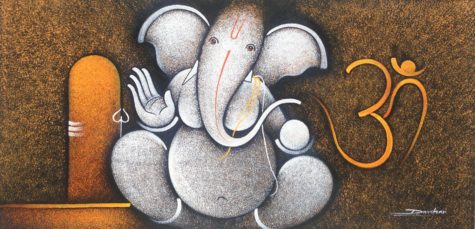
Shlokas on Lord Ganesh:
Shuklaambara Dharam Vishnum
Shashi Varnam Chatur Bhujam
Prasanna Vadanam Dhyaayet
Sarva Vighna Upashaanthaye
Meaning: We meditate on Lord Ganesha – who is clad in white (representing purity), who is all pervading (present everywhere), whose complexion is gray like that of ash (glowing with spiritual splendor), who has four arms, who has bright countenance (depicting inner calm and happiness) and who can destroy all obstacles (in our spiritual and worldly path).

Vakratunda Mahakaaya
Suryakoti Samaprabha
Nirvighnam Kuru Mey Deva
Sarva Kaaryeshu Sarvada
Meaning: The Lord with the curved trunk and a mighty body, who has the luster of a million suns, I pray to thee Oh Lord, to remove the obstacles from all the actions I intend to perform.

Agajaanana Padmaarkam
Gajaananam Aharnisham
Anekadantham Bhaktaanaam
Ekadantam Upaasmahey
Meaning: I worship day and night that elephant faced Lord Ganesha who is like sun to the lotus face of Mother Parvati. Giver of many boons, the single tusked Ganesha, I salute Thee to give me a boon.

Gajaananam Bhoota Ganaadhi Sevitam
Kapitta Jamboophaala Saara Bhakshitam
Umaasutam Shoka Vinaasha Kaaranam
Namaami Vighneswara Paada Pankajam
Meaning: The Lord with the elephant face, served by all the Ganas, One who takes as His food, the essence of Kapitta and Jamboophala (these are two favorite fruits of Ganesha), son of Uma (Mother Parvati), destroyer of misery of the devotees, controller of obstacles, we worship Your Lotus Feet.

Ganaanaam Twam Ganapathi Gam Havaamahe
Kavim Kaveenaam Upamasra Vastamam
Jyeshta Raajam Brahmanaam Brahmanaspatha
Aanashrunvanna Oothibhi Seedha Saadanam
Meaning: We invite You, the Lord of spiritual faith (of Lord Shiva). You are the wisest among the wise, the best to be given as a standard of comparison. You are the senior Lord, Lord of the Vedic mantras, listening to our prayers. Please visit our home with prosperous things and be seated here.
 GANESH GAYATHRI
GANESH GAYATHRI
Tatpurushaaya Vidmahe
Vakratundaaya Dheemahe
Tanno Danthihi Prachodayaat
Meaning: We meditate on that super power, we invoke the single tusked boon giver, Ganesha.

GANESHA PANCHARATNAM
Mudakaraatha Modakam Sada Vimukti Saadhakam
Kalaadharaavatamsakam Vilasiloka Rakshakam
Anaaya Kaika Naayakam Vinasitebha Daityakam
Nataasubhasu Naashakam Namaami Tham Vinaayakam.
Meaning: I prostrate before Lord Vinaayaka who joyously holds modaka in His hand, who bestows salvation, who wears the moon as a crown in His head, who is the sole leader of those who lose themselves in the world. The leader of the leaderless who destroyed the elephant demon called Gajaasura and who quickly destroys the sins of those who bow down to Him, I worship such a Lord Ganesha.

Natetaraati Bheekaram Navoditaarka Bhaasvaram
Namat Suraari Nirjanam Nataadhi Kaapa Duddharam
Suresvaram Nidheesvaram Gajesvaram Ganeshvaram
Mahesvaram Samaasraye Paraatparam Nirantaram.
Meaning: I meditate eternally on Him, the Lord of the Ganas, who is frightening to those not devoted, who shines like the morning sun, to whom all the Gods and demons bow, who removes the great distress of His devotees and who is the best among the best.

Samasta Loka Samkaram Nirasta Daitya Kunjaram
Daredarodaram Varam Vare Bhavaktra Maksharam
Krupaakaram Kshamaakaram Mudaakaram Yasaskaram
Manaskaram Namaskrutaam Namaskaromi Bhaasvaram.
Meaning: I bow down with my whole mind to the shining Ganapati who brings happiness to all the worlds, who destroyed the demon Gajasura, who has a big belly, beautiful elephant face, who is immortal, who gives mercy, forgiveness and happiness to those who bow to Him and who bestows fame and a well disposed mind.

Akimchanaarti Marjanam Chirantanokti Bhaajanam
Puraari Poorva Nandanam Suraari Garva Charvanam
Prapancha Naasha Bheeshanam Dhananjayaadi Bhushanam
Kapola Daana Vaaranam Bhajaey Puraana Vaaranam.
Meaning: I worship the ancient elephant God who destroys the pains of the poor, who is the abode of Aum, who is the first son of Lord Shiva (Shiva who is the destroyer of triple cities), who destroys the pride of the enemies of the Gods, who is frightening to look at during the time of world’s destruction, who is fierce like an elephant in rut and who wears Dhananjaya and other serpents as his ornaments.

Nitaantikaanta Dantakaanti Mantakaanta Kaatmajam
Achintya Rupa Mantaheena Mantaraaya Krintanam
Hrudantarey Nirantaram Vasantameva Yoginam
Tameka Danta Meva Tam Vichintayaami Santatam.
Meaning: I constantly reflect upon that single tusked God only, whose lustrous tusk is very beautiful, who is the son of Lord Shiva, (Shiva, the God of destruction), whose form is immortal and unknowable, who tears asunder all obstacles, and who dwells forever in the hearts of the Yogis.

Mahaaganesa Pancharatnam Aadarena Yonvaham
Prajapati Prabhaatake Hrudi Smaran Ganesvaram
Arogatham Adoshataam Susaahitim Suputrataam
Samaahitaayu Rastabhootim Abhyupaiti Sochiraat.
Meaning: He who recites this every morning with devotion, these five gems about Lord Ganapati and who remembers in his heart the great Ganesha, will soon be endowed with a healthy life free of all blemishes, will attain learning, noble sons, a long life that is calm and pleasant and will be endowed with spiritual and material prosperity.
From: Saidarshan.org
Twelve Names of Ganesha

We already explored the 108 names of Ganesh, but these twelve names are in the form of a shloka, which is a verse, proverb, hymn or poem that uses a specific meter. This group of verses is said to be sage Narada’s offering to Lord Ganesh. So, if you like doing these Sanskrit chants, here are some more. I think this is meant to be recited in its entirety, rather than bits and pieces.

Pranamya Shirasa Devam
Gauriputram Vinaayakam
Bhakataavaasam Smare Nityam
Aayuh Kaamartha Siddhaye
Meaning: Every day, I bow down to that Lord, the son of Gowri, the Lord one who lives in the heart of the devotees, blessing them always with good health and prosperity.
Prathamam Vakratundam Cha
Ekadantam Dviteeyakam
Thriteeyam Krishna Pingaaksham
Gajavaktram Chaturthakam
Meaning: Starting from here the twelve names of Ganesha are mentioned and he is worshiped in those different forms. The first as the Lord with the curved trunk; second, as the one with only one tusk, third, as the one with black (red/brown) eyes, fourth, as the one with giant structure.
Lambodaram Panchamaam Cha
Shashtam Vikatameva Cha
Saptamam Vighnaraajendram
Dhoomravarnam Tathaashtamam
Meaning: Fifth, as the one with a big (long) stomach, six, as the one with a huge body Seven, as the remover of obstacles, eight, as the one with smoke gray color
Navamam Phaalachandram Cha
Dasamam Tu Vinaayakam
Ekaadasam Ganapatim
Dvaadasam Tu Gajaananam
Meaning: Ninth, as the one with moon on the front of His head, tenth, as the foremost leader, eleventh, as the leader of the ganas, twelfth as the one with elephant face.
Dvaadasaitaani Naamaani
Trisandhyam Yah Pathernnarah
Na Cha Vighna Bhayam Tasya
Sarva Siddhikaram Prabho
Meaning: Any person, who remembers these twelve names of Ganesha, three times in a day, will have all their obstacles and fear removed and will attain success.
From: Saidarshan.org
Sixteen Names of Ganesha
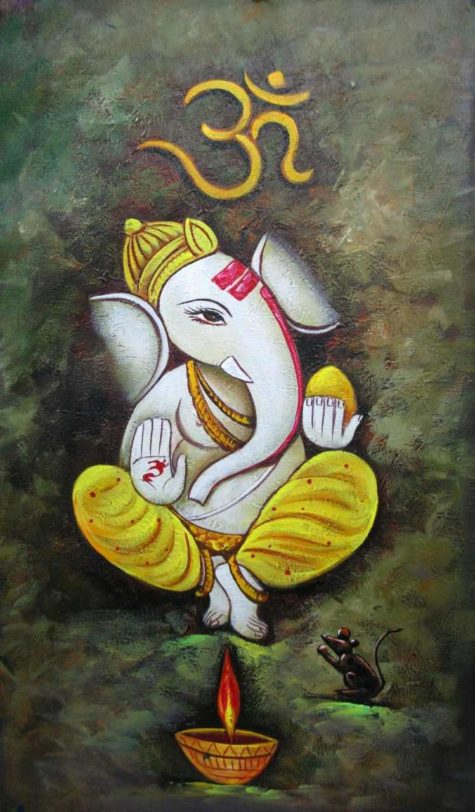
Sumukhascha Ekadanthascha
Kapilo Gajakarnakaha
Lambodarascha Vikato
Vighnaraajo Ganaadhipaa
Meaning: The various names and associated forms of God Ganesha are enumerated and need to be meditated upon here – the one with an auspicious face, the single tusked Lord, the one who is of red color, the one with the ears of an elephant, the one with a big stomach, the one with a jovial disposition, the controller of obstacles, the Lord of the Ganas.
Dhoomaketur Ganaadhyashah
Phaalachandro Gajaanana
Vakratundo Shoorpakarno
Heyrambho Skandapoorvajaha
Meaning: The one of smoke gray color, the leader of the ganas, the one who has moon in the front of his forehead, the elephant faced one, the one with a curved trunk (or broken tusk), the one with big (basket like) ears, the one who is heroic like a buffalo, the elder brother of Skanda (Skanda is another name for Lord Subrahmanya)
Shodashaitaani Namaani
Yah Pateth Srunuyaadapi
Vidyaarambhe Vivahe Cha
Praveshey Nirgamey Tatah
Sangraamey Sarva Kaaryeshu
Vighnas Tasya Na Jaayathe
Abheepsitaartha Siddhyartham
Poojitoya Surairapi
Sarva Vighna Chhido Tasmai
Sree Ganaadhipataye Namaha
Meaning: Whoever the one who recites and listens to these sixteen names at the beginning of studies, at the time of marriage, while entering or departing a place, or at the battle field, all their obstacles will be removed. Even the Gods worship Lord Ganesha to receive the fulfillment of their actions. Oh Lord Ganesh, the One who has this power of destroying all the obstacles in the way of the devotees, I prostrate before you.
From: Saidarshan.org
Other Ganesh Mantras
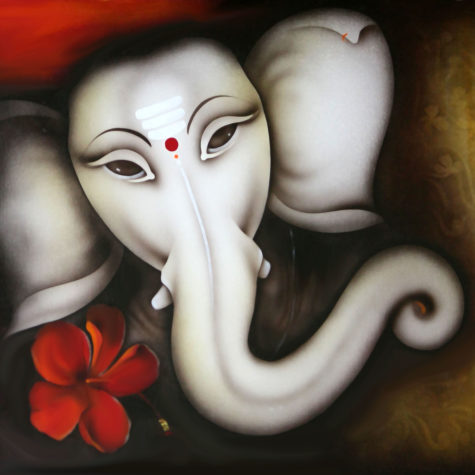
- Aum Shri Ganeshaya Namah.
This is the mantra of invocation, adoration and worship. It means ” Praise to Lord Ganesha“. It is repeated at the beginning of religious ceremonies and mantra recitation to invoke Ganesha’s blessings for the auspicious beginning of a task, project, change of life, community undertaking or simply to offer Him praise.
This mantra is usually taught to children for their good education. It increases their memory power, and they become successful in their examinations. Of course, people of any age may use this mantra when taking courses in a school or university, and for success in attaining their degree.
- Aum Gum Ganapataye Namaha.
This is Lord Ganesha’s mula (“root”) mantra. It is also known as His bija mantra, for it combines Ganesha’s bija (“seed”) sound, “gum,” with the phrase, “Praise be to Ganapati.” This is a mantra from Ganapati Upanishad. One may always use it before beginning a journey, new career or job, or before entering into any new contract or business so that impediments are removed and your endeavor may be crowned with success.
- Aum Vakratundaya Hum.
This is a very powerful mantra. When something is not working properly, individually or universally, nationally or internationally, or when the minds of the people turn crooked, negative, depressed or discouraged, the attention of Ganesha may be drawn by this mantra to straighten their ways. The HUM symbolizes “Delay no more, my Lord, in straightening the paths of the crooked-minded ones.”
In addition, this mantra could also be used for healing any spinal deficiency, such as curvature of the spine or curved limbs. Dedicate 1,008 repetitions of this holy word to straighten and heal such deficiencies.
- Aum Kshipra Prasadaya Namah.
Kshipra means instantaneous. If some danger or negative energy is coming your way and you don’t know how to get rid of that trouble, with true devotion, practice this mantra for quick blessing and purification of one’s aura.
- Aum Shrim Hrim Klim Glaum Gam Ganapataye Vara Varada Sarva Janamme Vashamanaya Svaha.
There are several bija (seed) mantras in this mantra . Among other things, it signals, “Shower Your blessings, O Lord. I offer my ego as an oblation.”
- Aum Sumukhaya Namah.
This mantra has a lot of meaning, but to make it simple, it means you will be always very beautiful in soul, in spirit,in face, everything. By meditating on this mantra, very pleasing manners and a beauty comes on you. Along with that comes peace, which constantly dances in your eyes; and the words you speak are all filled with that power of love.
- Aum Ekadantaya Namah.
Ekadanta refers to one tusk in the elephant face, which means God broke the duality and made you to have a one-pointed mind. Whoever has that oneness of mind and single-minded devotion will achieve everything.
- Aum Kapilaya Namah.
Kapila (red) means that you are able to give color therapy. You are able to create colors around yourself and around others, bathe them in that color and heal them. As per the mantra you create, so will you create the colors. Another meaning is “wish cow,” the “cow of plenty.” It means that whatever you wish, that comes true. There is a wish-cow inside you. Whatever you wish, especially for healing others, comes true immediately.
- Aum Gajakarnikaya Namah.
The ears of Ganesha, the elephant, are constant fanning, which means people may talk a lot,but you are not receiving inside anything other than that which is important.It also means that you can sit anywhere and tune this cosmic television (the body) with seven channels (chakras) and all 72,000 nadis, to any loka and be able to hear ancestors, angels, the voice of God or the voice of prophets. That kind of inner ear you will develop through this mantra.
- Aum Lambodaraya Namah.
This means you feel that you are this universe. It means that all the universes are within you. Like an entire tree is in the seed, the whole universe is in the sound of creation, which is Aum, and that Aum consciousness in you makes you feel that you are the universe. Therefore, if you say, realizing the oneness with the universe, “shanti to the world” every day, then the grace of God will come and there will be world peace, universal peace. It is the universes within Aum and Aum within you.
- Aum Vikataya Namah.
This means realizing this world as a dream or a drama. When you are in that high consciousness, this whole world looks like a dream. All of us have taken a role. We have to play our role in life as wife or husband or children or citizens, all consistent with the role we have taken.
When an actor bitten by a sponge cobra that is brought on the stage falls, the entire audience cries; but that boy who has fallen knows it was not a real cobra and he is not dead. Life is a drama –definitely life in this material world, this physical world of ego, is a drama. But inside, like the boy on the stage who is quite happy knowing that he didn’t die by the bite of the sponge cobra, like that, the truth never dies in us; it is immortal. So everything else you consider as drama. That consciousness comes to you by knowing this mantra.
- Aum Vighna Nashanaya Namah.
This mantra invokes the Lord Ganesha to remove every impediment in your life and in your works. By constant meditation on this mantra, all obstacles and blocked energy in your physical and astral bodies are released.
- Aum Vinayakaya Namah.
Vinayaka is the name of Ganesha in the golden age. So by realizing this mantra, your life will have a golden age. In your office, in your work, you’ll be the boss. Vinayaka means something under control. Vinayaka means the Lord of problems.
- Aum Ganadhyakshaya Namah.
This mantra is so important. Suppose you have a group, a country, neighbors, or any kind of group therapy, group healing or a whole country needing healing, then you have to bring that entire group to your mind’s arena and say this mantra. A group healing takes place by this mantra.
- Aum Bhalachandraya Namah.
In Sanskrit, bhala means the forehead center. Chandra means the crescent moon. Bhalachandra means that chakra from where the nectar drips. That is the secret of all healing. It is to feel yourself as Siva, identifying yourself with the Truth and feeling constantly that you are carrying the crescent moon, the symbol of growth and nectar and peace.
from Loving Ganesa
by Satguru Sivaya Subramuniyaswami
The Ganesh Mantra
From Mind Valley, here are 6 benefits to a regular practice of chanting the Ganesh Mantra. I’m sure there are many more.
- The Ganesh Mantra is known to activate the mind and various chakras of the body. This leads to better blood circulation and therefore improved metabolic rate in the body.
- It is said that it is best to chant the Ganesh Mantra before undertaking a new venture, as he is the bringer of success, prosperity, and good luck.
- Chanting the Ganesh Mantra also brings peace, or more literally – it removes all enemies from one’s path.
- It helps us focus.
- It brings clarity into our lives
- It is also said that if you chant the Ganesh Mantra 1008 times, it will remove fear from your heart.
What is the Ganesh mantra?
Well, actually there are a number of different Ganesh Mantras. The one we used for our original project was this one: Om Gam Ganapataye Namaha.
A loose translation might be:
- Om = The sound of the universe
- Gam = The secret power sound of Ganesh. It is his “seed syllable” or bija mantra.
- Ganapataye = Another name of Ganesh, the remover of obstacles.
- Namaha = I submit to a higher power.
The pronunciation is also pretty easy:
- Om = ohm or aum
- Gam = Somewhere between “gahm” and “gum”. In some dialects it is “guhng”.
- Ganapataye = gah-nah-paht-ah-yeh
- Namaha – nah-mah-hah
Repetition of this mantra over and over again brings peace, and is designed to help remove anything that might be blocking your progress. Some of us used the whole mantra, and some of us just used the bija or seed sound for the Ganesh Mantra, which is “Gam” and sounds like “gum.”
The mantra can be chanted aloud, or silently, or a combination of the two. You might want to do this as a regular meditation practice, or you can simply chant the mantra while on your way to work, whenever anything comes up that feels overwhelming, if you find yourself in a whirlpool of anxious thoughts, while walking, jogging, or even when falling asleep at night.
